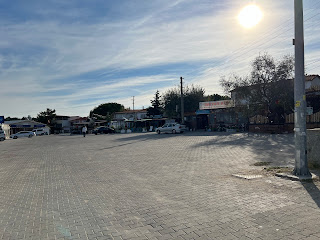In the evening, we set sail from Istanbul and woke up on Monday, October 14 in Canakkale, Turkey. Çanakkale is a city and seaport in Turkey on the
southern shore of the Dardanelles at their narrowest point. What are the Dardanelles? The Dardanelles, also known as the Strait of Gallipoli and
in Classical Antiquity as the Hellespont, is a narrow, natural strait and
internationally significant waterway in northwestern Turkey that forms part of
the continental boundary between Asia and Europe and separates Asian Turkey
from European Turkey.
We boarded our bus quite early and headed out for the day.
The scenery as we were driving along was beautiful. We saw lots of individual "crops" that folks were growing for their own use.
We were headed to Alexandria/Troas
We hiked up a small hill.
At the top of the hill, we could look down below in the water and see parts of ancient columns. This is called the antique harbor. There was more to this area when Paul was around. Paul, the one in the Bible, set out to European soils for the first time from this harbor on his second
missionary journey. On his third journey he came to this harbor once again and
stayed in Alexadria Troas for a week and he was preaching during that time.
It was gorgeous. When Paul was there, he had a vision in which he was called to Macedonia.
A story I've always loved about Paul was when Eutychus was sitting in the window while Paul preached. Eutychus fell asleep and fell out of the window and died!! Paul brought him back to life. That event is recorded in the Bible in the book of Acts and happened here in Alexandria/Troas.
This little boat was FULL of empty bottles - wine, liquor, beer - all the bottles.
We were able to go down on the beach and it was so pretty.
I love this shadow photo!!!
For the bus to get in and out of this location was a tight squeeze through a tiny neighborhood and the tiny streets in that neighborhood.
We headed back to the ruins of Alexandria Troas. We saw just a part of the ruins - they are on both sides of the road . . .basically in fields! You might be out working your land one day and stub your toe on something and find out it was part of an ancient city.
The road below was one of the main things we wanted to see and touch. This road dates back to Paul's time. Paul would have actually walked on this road. This isn't one of those places where something "maybe" happened. This is where it happened.
We grabbed a group photo.
The details on ornamental pieces are amazing.
I think the city was founded in 310 BC - or something like that. The city had temples, a bath, a stadium, a gymnasium, and a port.
We wore hats and sunglasses a LOT.
We headed to lunch at a restaurant that could seat a crowd.
They served "salads" first.
They brought us a plate of chicken and rice and meatballs with cauliflower and broccoli.
I wonder if this is the day that Mark had to miss because I'm sitting with all girls at lunch that day. He had Pharaoh's revenge - like some others on the trip.
The bus was parked across the street - this was what the restaurant looked like from the outside.
We headed to Troy after lunch. Our travel documents said that "In Troy, history is buried in myth and mud. Nine layers of the fabled city have been excavated." The sign below says that the favorable location caused it to be reoccupied time and again over more than 3000 years. Sundried mudbrick was largely used for building the walls of houses.
The lower seven settlements, Troy I-VII, contain the remains of forty-one building phases. On top of these come the remains of Greek (VIII) and Roman (IX) constructions. All of these mounds produced an artificial accumulation of earth that is nearly 20 meters high. 20 meters is almost 22 yards.
The firsst excavations of Troy began in 1856 and continue to this day.
These walls of bricks were amazing. They were so similar in size.
There were wooden walkways which did indeed make walking easier!
Below is fascinating! They found some of the foundation from 2500BC -- your read that correctly - 2500 BC. There were mud bricks on top. They've added some new mud bricks trying to protect the old and to show a larger reconstruction. The whole thing is covered over by a UNESCO-funded shelter and walkways. These walls were part of the Citadel wall.
Below photo shows a ramp from 3500 years ago.
The ramp led to a palace.
The theater/stadium is below. Concerts, lectures, and other events took place in the theater.
Last but not least -- a recreation of the Trojan Horse - Homer's Iliad relates teh legendary story of the Trojan War.
We headed back to the ship for another gorgeous view!
Back on the ship, Brian gave another talk/lecture -- I think this was "The Trojan Horse of Golgotha: Paul's Understanding of the Cross."




































































Hi Lisa, oh my, what a tour. Thank you for sharing. :-) Love the sunglasses and hats.
ReplyDeletexxoo
Carla
I checked your recent posts - they're great. BTW, I bet that, unless you have some physical problem, a nice alto like you could sing again with a vocal coach, but I'm biased, admitedly.
ReplyDelete